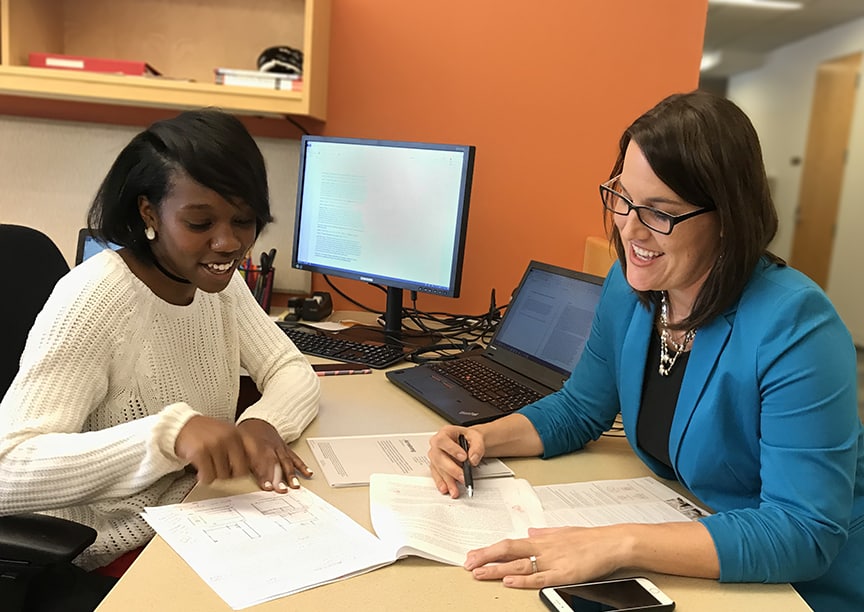In my late teens, I had the opportunity to be a substitute teacher/teacher’s assistant for toddlers at a childcare facility. It was an eye-opening experience, but for more reasons than some would assume. Working there during the summers, I was able to see first-hand how children interacted within spaces supposedly designed for them. Additionally, I witnessed the teacher’s interaction. I could see their frustrations in certain design elements in the classrooms and supportive spaces.
What I observed led me to wonder: how could the space be designed better for children to learn and grow?
So, here I am this semester, continuing exploratory research with the intention of creating a framework designers can use in the initial process of planning unique educational environments for specialized populations. Going into my final semesters of my design education, it feels like a journey where the destination is filled with both excitement and anticipation.
Working with children and having a child psychologist as a sister sparked my interest in designing better educational spaces for its users. My first thesis addressed the impact of spatial design in childcare spaces for children who may have experienced trauma, abuse, or neglect. A 2014 Children’s Defense Fund study noted that out of 500,000 children in the US, a little over 78% of those children have been neglected and 18% of them have been abused.
Understanding that statistic was the beginning of my drive to address this issue. If children are our future, we must have spaces where they can feel safe and positively grow.
After completing my thesis, I was afraid of not being able to continue this research – and my thesis book, along with the research, would stay underneath my bed and collect dust forever. Fortunately, the University of Minnesota’s School of Architecture’s Consortium for Research Practices gave me the opportunity to visit this research one more time.
One of the unique things about this program is the ability for the student to be in control and decide which firm will best assist them in their research endeavors. As a double minority in this profession, I had certain criteria and expectations (e.g. projects geared toward well-being, behavior, and children, women in leadership roles, etc.) when looking for a firm I believed would be a good fit for me and vice versa. Through intense research of all the firms within the Consortium, I found BWBR to be a great fit for me personally and professionally. Through working with BWBR and the University of Minnesota, I was able to participate in a two-semester exploratory research study to begin to understand how acoustics within a K-8 classroom setting can impact the behavior of children with Emotional Behavior Disorder (EBD) and Developmental Coordination Disorder (DCD).
There is a considerable absence of research pertaining to the influence of acoustics on behavior of children with special needs and more specifically children with EBD and DCD. My research with BWBR sought to address this gap by undertaking an exploratory study of acoustics in K-8 classroom environments. The goal of the exploratory research was to develop a better understanding of classroom acoustical design specifically geared toward the unique learning experiences of these specialized populations in hopes of informing future design of special education environments.
Over the course of the two semesters, I conducted design professional interviews, staff surveys, and school observations. After the initial data analysis, I found acoustics may have a direct connection to behavior of children with EBD and/or DCD, although there also may be other factors besides acoustics that may trigger behavior as well. While there are still elements to understand better, the research has already revealed that designers cannot afford to ignore some of the environmental qualities over others; that all elements of a nurturing environment need to be considered.
My passion for encouraging and helping children probably comes from the same support I received growing up. In that first job I had at 17, I watched the children, not all who had the best upbringing at their homes. From that experience, I vowed to myself to create better spaces for children in education at every opportunity.
Because design has so much of an impact on users, especially children, it’s our duty on designers to make sure we are creating spaces with our users truly in mind. I look forward to sharing this research – hopefully having it published – with the design community and education professions, alike, to do better for the children.
Angella Dariah is an intern at BWBR and a Master of Science candidate at the University of Minnesota School of Architecture. She is originally from Connecticut and received her Master of Architecture degree from Hampton University in Virginia.








